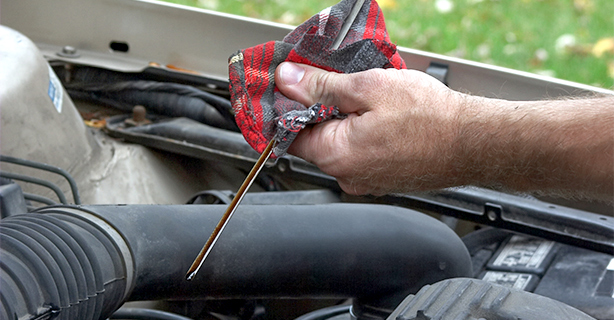4 steps to check and refill your car’s oil
With recent advancements in motor oils and engine technologies, newer vehicles have longer recommended oil change intervals—typically between 5,000 and 10,000 miles. However, if you notice oil leaking from your car, the oil can symbol appears on your dash, or you feel your engine isn’t running as smoothly as normal, you may need to add oil between oil changes.
Check out these four easy steps to check and refill your car’s engine oil. Keep in mind, topping off your oil doesn’t replace the need for regular oil changes, and a consistent oil leak or engine trouble should be looked at by a mechanic. Always check your owner’s manual for specifications, including oil change intervals and the type of oil to use in your car.
1. What you need to check and add oil to your car
Before you begin, make sure you've got everything on hand to check and put oil in your car. Here's what you'll need:
Engine oil: It's important to make sure you have the correct type of oil for your car. Mixing different types of oil can negatively impact your engine's performance and even cause damage.
Funnel: Using a funnel is the fool-proof way to get oil into your car without spilling it.
Towel: Oil can be dirty—be sure to have clean, disposable towels nearby to check the oil and help clean up any messes.
Rubber gloves: Oil can stain your hands, but rubber gloves can help keep them clean.
2. How to check the oil in your car
Park your car on a flat surface before you start working. Parking on a hill or slope can affect oil level readings.
Your car's dipstick is located under the hood in the engine bay. It should be a loop or T-shaped handle marked “engine oil,” and is typically yellow or marked with yellow text, making it easier to find. Remove the dipstick, wipe it clean with a dry towel, replace it until it clicks into place, and pull it out again. Check the level of the oil on the dipstick.
If it reads at or below the “low” or “add” line—or if there's no oil on the dipstick at all—you'll need to add oil. If it comes out above this line in the “full” section, the oil level is fine and you don't need to add oil.
3. How to add engine oil to your car
To top off the oil, locate the oil filler cap on the engine. It should be a round, black cap, typically marked “engine oil” or with a drawing of an oil can. Remove the cap and place a clean funnel at the top of the spout to prepare to add the oil.
Double-check that you're using the correct oil for your car, then add about half of a quart. If your oil level was in the “add” section of the dipstick when you checked, you'll likely need to add at least one quart of oil, but it's better to add it in smaller increments to avoid overfilling.
4. Re-check the oil level
Use the clean dipstick to check the oil level again, making sure it's at the proper level. If it still needs more, add another half quart and check it again until the dipstick shows there's enough oil in your engine.
If there's still no oil on the dipstick after adding a quart or two, don't start your car. Give your local mechanic a call to take a look.
Once your oil is at the proper level, remove the funnel and replace the oil cap and dipstick before closing the hood. Don't forget to routinely schedule or perform a full oil and oil filter change as well.
Related links
Doing your own basic car repairs can also help you save money. For example, it’s good to know how to change a flat tire so you don’t have to call a tow truck.
Looking for more ways to save on vehicle expenses? Check out these 7 tips to improve your car’s gas mileage to help ease your burden at the pump.
The general information in this blog is for informational or entertainment purposes only. View our blog disclaimer.
*Data accuracy is subject to this article's publication date.






